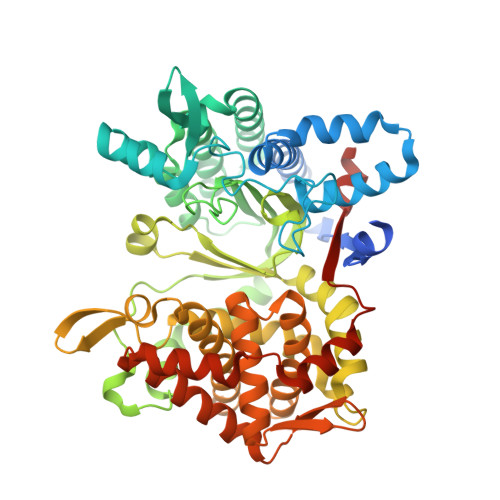The first dipeptidyl peptidase III from a thermophile: Structural basis for thermal stability and reduced activity.
Sabljic, I., Tomin, M., Matovina, M., Sucec, I., Tomasic Paic, A., Tomic, A., Abramic, M., Tomic, S.(2018) PLoS One 13: e0192488-e0192488
- PubMed: 29420664
- DOI: https://doi.org/10.1371/journal.pone.0192488
- Primary Citation of Related Structures:
6EOM - PubMed Abstract:
Dipeptidyl peptidase III (DPP III) isolated from the thermophilic bacteria Caldithrix abyssi (Ca) is a two-domain zinc exopeptidase, a member of the M49 family. Like other DPPs III, it cleaves dipeptides from the N-terminus of its substrates but differently from human, yeast and Bacteroides thetaiotaomicron (mesophile) orthologs, it has the pentapeptide zinc binding motif (HEISH) in the active site instead of the hexapeptide (HEXXGH). The aim of our study was to investigate structure, dynamics and activity of CaDPP III, as well as to find possible differences with already characterized DPPs III from mesophiles, especially B. thetaiotaomicron. The enzyme structure was determined by X-ray diffraction, while stability and flexibility were investigated using MD simulations. Using molecular modeling approach we determined the way of ligands binding into the enzyme active site and identified the possible reasons for the decreased substrate specificity compared to other DPPs III. The obtained results gave us possible explanation for higher stability, as well as higher temperature optimum of CaDPP III. The structural features explaining its altered substrate specificity are also given. The possible structural and catalytic significance of the HEISH motive, unique to CaDPP III, was studied computationally, comparing the results of long MD simulations of the wild type enzyme with those obtained for the HEISGH mutant. This study presents the first structural and biochemical characterization of DPP III from a thermophile.
Organizational Affiliation:
Division of Physical Chemistry, Ruđer Bošković Institute, Zagreb, Croatia.




















